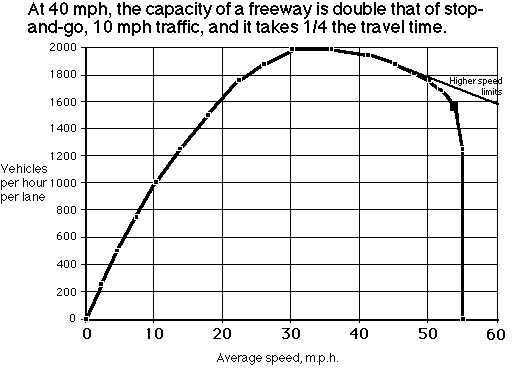Traffic congestion can be reduced or eliminated! All items below cost very little. Any by themselves would decrease traffic congestion. Together, they would eliminate it.
1) Implement employee parking cash-out (equalizing the parking subsidy). This would have an immediate impact of reducing car commuting by 25%.
2) Raise the gas tax in a "revenue neutral" manner. At present, about half of local road costs are paid for by property taxes. "Revenue neutral" means all gas tax proceeds would go toward reducing property and sales taxes. In California, a gas tax can now be implemented at the county level.
3) Abolish all automobile subsidies (direct and indirect) and pay for this from the gas tax and/or other auto user fees.
4) Institute "Fare Lanes." These let anyone use carpool lanes, but charges them a fare per car. Use existing lanes of roads. Do not add more lanes.
5) Eliminate all "traffic mitigation fees" and "developer fees" and "parking assessment fees" that subsidize the automobile. Alternatively, use these fees for constructing guideway transit instead of automobile-related construction that encourages greater auto use.
6) Eliminate parking requirements in industrial areas (and ideally, everywhere). If necessary, implement parking permits for neighborhoods (already common in some cities).
7) Implement traffic calming to create a more livable neighborhood and decrease automobile dependency. This will also decrease auto usage.
8) Any congestion still remaining will be eliminated by use of congestion pricing. This means charging for road use an amount that varies so that traffic is kept moving. As rush hour approaches, the price increases in stages in order to keep total cars using the facility at the same optimal flow level. The money raised could be used to build guideway transit because road users also benefit by paying for potential motorists to use alternatives. Congestion pricing also increases highway capacity (see graph, below), while reducing political pressure for more highway construction. [Details]

9) If any new lane or road is constructed, use non-stop toll collection (we call them "road fares") to pay for it. All moneys for the new lane or road needs to be paid for by its direct users and preferably privately financed to guaranty that there would be no government subsidy. The roadway needs to pay the same property tax rate as railroads, to be fair.
Increasing highway capacity increases auto usage, and the same congestion as today returns soon (in as little as two years) after construction. It does not decrease congestion in the long term. This effect is called induced traffic. It is well-documented.
The concepts in this page are detailed in the report Free Market for Transportation Plan. This page is a brief, and was written to provide viable solutions for traffic congestion that counter the non-solutions proposed by special interests campaigning to raise the sales tax for more freeway construction and more subsidies to the automobile.